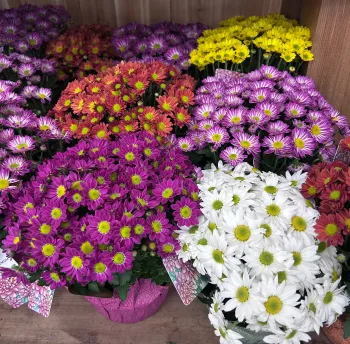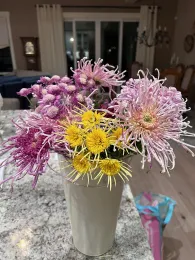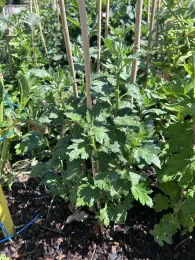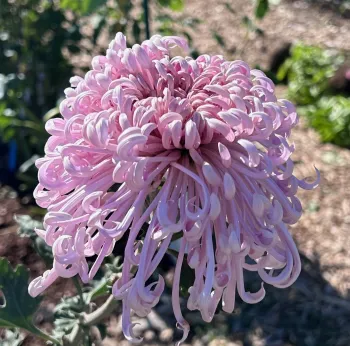
Article and photos by Pam McCabe -
In September, potted or florist chrysanthemums (mums for short) start appearing in supermarkets and garden centers in hues of yellow, orange, brown, and burgundy. They are meant to be used for seasonal décor and discarded at the end of the season. They may overwinter in a mild climate, but they generally are grown as annuals. In the 1960s and 70s major plant growers shifted their focus to pot mums and this led to a decline in heirloom cut flower cultivation. Potted varieties have smaller flowers that are grown in a mounded shape.
Heirloom chrysanthemums are easily propagated by cuttings or divisions. Heirloom chrysanthemums can be grown in all fifty states and in all planting zones but they do best in zones 5-9. You currently cannot buy heirloom chrysanthemums in garden centers. A few online companies sell rooted cuttings, or you can purchase from Sacramento or Bay Area chrysanthemum societies’ cutting or potted plant sales. The rooted cutting sales are in late May or early June. One-gallon plants are sometimes sold at annual chrysanthemum exhibition shows in November.

The National Chrysanthemum Society (NCS) was formed in 1949. NCS plays a crucial role in promoting and improving the cultivation of chrysanthemums. The NCS provides resources and guidance on chrysanthemum propagation, cultivation, and exhibiting, while also encouraging wider appreciation for these flowers. The organization developed a classification system that includes all US recognized cultivars. The system includes thirteen classes, with designations by size, color, response, and use. Response refers to the approximate dates the cultivar will bloom – early, mid, or late. Early cultivars bloom by September 30, mid-cultivars bloom October 1-22, and late cultivars bloom October 23 into December.
Chrysanthemums are short-day plants, which means they require longer periods of darkness to form flowers. As days naturally shorten in late summer and early fall, chrysanthemums respond to these changes by initiating the process of setting flower buds. Short-day plants form flowers only when day length is less than about twelve hours. Chrysanthemums come in a wide range of colors, including white, yellow, green, pink, purple, bronze, and red. NCS also classifies cultivars by “use” which refers to the form in which the cultivar will perform best. Although NCS lists nine use keys, most heirloom chrysanthemums fall into the disbud (disbudded for one large bloom per stem) or spray (for a profusion of blooms).

American cut flower growers have recently discovered heirloom mums. They are recognizing their unique beauty and suitability for cut flower production, which gives them three more months of flower production. The flowers bloom when other flowers are finished, have a long vase life, come in spectacular forms, and a variety of colors. Most of the long-stem chrysanthemums sold at supermarkets and florists are imported from South America, mostly Colombia.
I will briefly outline the cycle of growing heirloom chrysanthemums. Online sellers of rooted cuttings generally take orders in January and send them in March or April. When you receive your cuttings, you should plant them in a three-inch pot, water them, and keep them protected until the roots start expanding into the pot, then, either plant them in the ground or pot them up into a gallon container. If you are growing your plants in the ground, they should be spaced eighteen inches apart. Fertilize with a balanced fertilizer and continue to water your plants. Watch for chrysanthemum aphids that love new growth – give them a strong spray of water and/or introduce ladybugs. When the plants are about five inches tall, start pinching off the top two to three inches of soft growth at the top of the plant. These pinched stems can be rooted for additional plants. Continue pinching until early July, keeping your plant about ten inches tall. As your plant gets taller, stake them. I stake with three four-foot bamboo stakes around each plant and wrap twine around the stakes to keep the plants upright. As they grow, add twine at the plant’s height and keep tucking the plants inside the bamboo supports. Continue fertilizing with a balanced fertilizer until late August, then switch to a low-nitrogen fertilizer to encourage blooms.

Some varieties will form several stems. For nice sized blooms, you should limit the stems to five. Those who are growing for exhibition limit the plant to three stems. Exhibitor growers disbud for one bud per stem in order to get the biggest, healthiest bloom. A home gardener can create multiple blooms or larger blooms according to how much they disbud.
Each cultivar has an expected bloom date, ranging from September to early December. When your chrysanthemums are finished blooming, let them go dormant. As the plant loses most of its leaves, cut it down to three to four inches and add a thick layer of mulch. Chrysanthemums form stolons, modified stems that grow horizontally along the ground at nodes to produce new plants. Once the new plants have formed roots, they can be separated and replanted. Another way to propagate heirloom chrysanthemums in late winter or early spring is to take cuttings of the tips of the plant and pot them up in three-inch pots. Either way, the cycle starts over. The original or mother plant and the stolon-propagated plants can produce flowers perennially, but growers find that they get better flowers when new plants are started by cuttings each year.

